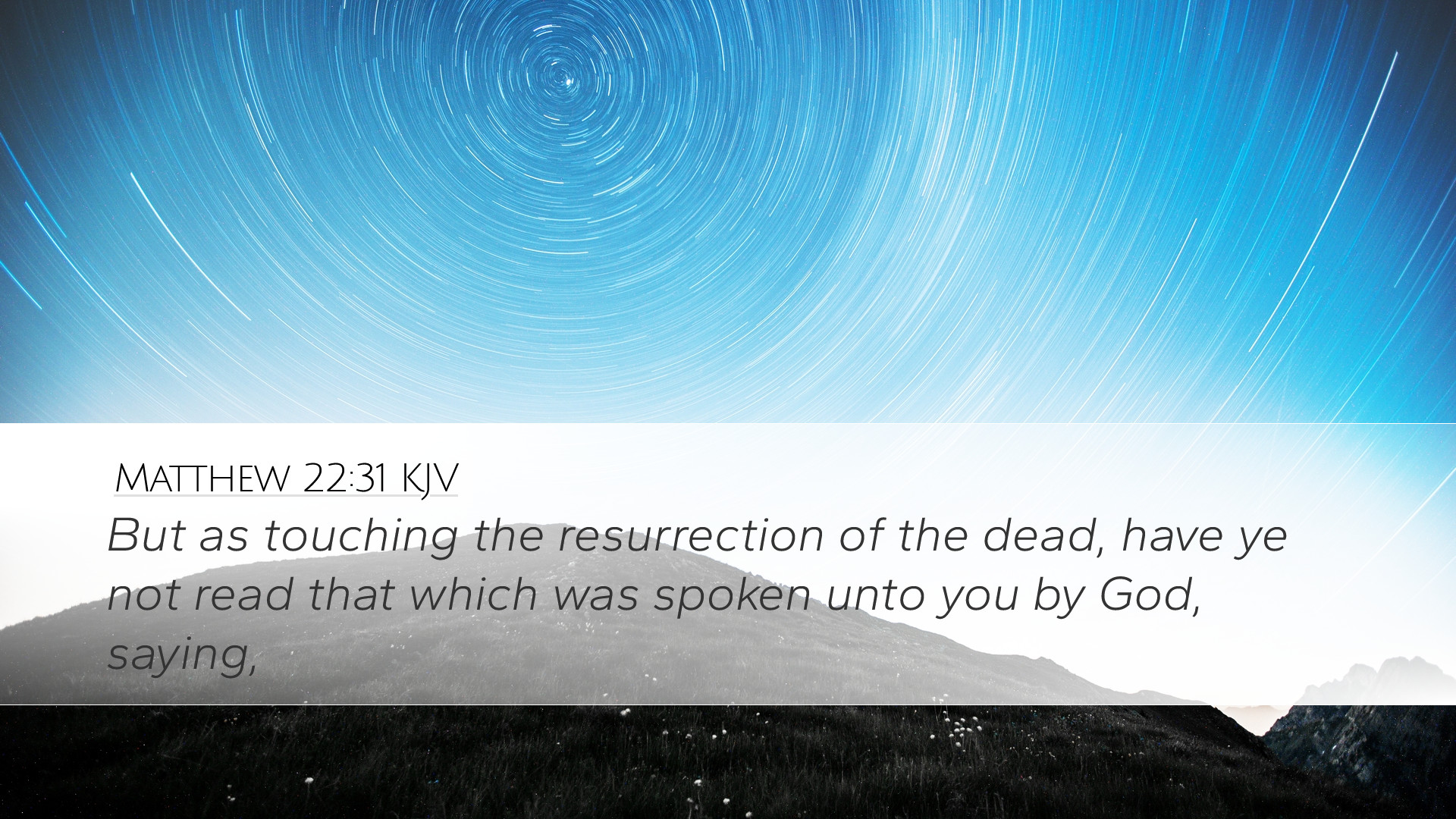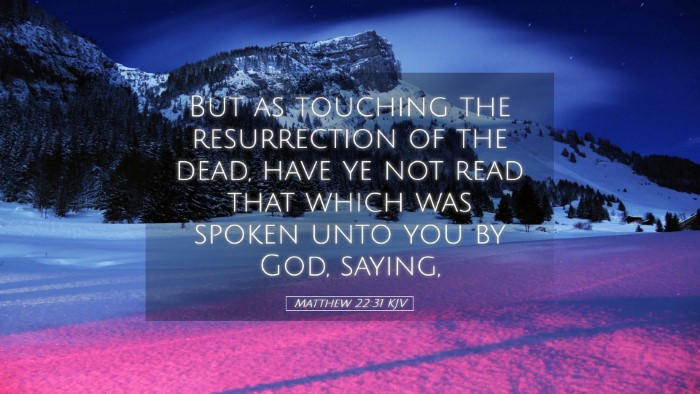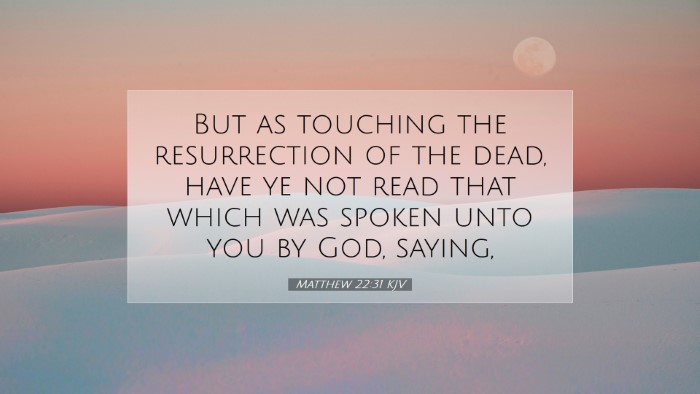Commentary on Matthew 22:31
Matthew 22:31 contains a significant discussion on the resurrection and the nature of existence beyond death. In this verse, Jesus is engaged in a dialogue regarding the resurrection, addressing the Sadducees, who deny the resurrection of the dead. This commentary will synthesize insights from several public domain resources, offering a rich exploration for pastors, students, theologians, and Bible scholars.
Text of Matthew 22:31
Matthew 22:31 (KJV): "But as touching the resurrection of the dead, have ye not read that which was spoken unto you by God, saying,"
Contextual Background
To properly interpret Matthew 22:31, it is crucial to understand the broader context of Jesus' ministry and the religious debates of His time. The Sadducees, a powerful Jewish sect, held a strict adherence to the Torah, rejecting the oral traditions upheld by the Pharisees. They questioned Jesus, intending to trap Him with a hypothetical scenario that involved levirate marriage to challenge the concept of resurrection.
Insights from Matthew Henry
Matthew Henry emphasizes the authority of Scripture in Jesus' response. He points out that Jesus refers to specific Scriptures to affirm the reality of the resurrection, validating the resurrection doctrine through God's declaration. Henry notes how Jesus effectively countered the Sadducees by demonstrating that God spoke of the living and not merely of the dead, illustrating that the relationship between God and His people transcends death.
- The Authority of God’s Words: Henry highlights the importance of recognizing God's voice in Scripture, asserting that what God has declared is not subject to human skepticism.
- Continuity of Existence: He argues that the verse teaches about the continued existence of God's people, emphasizing that they are not extinguished but are alive in His presence.
Insights from Albert Barnes
Albert Barnes offers a detailed analysis of the theological implications found in Matthew 22:31. He illustrates that the resurrection is not merely a future event but also affects the present understanding of life and death. Barnes further brings forth the idea that Jesus cites Exodus 3:6, reminding the Sadducees that God’s covenant with Abraham, Isaac, and Jacob suggests they still exist, as God is not a God of the dead but of the living.
- The God of the Living: Barnes explains that the phrase implies a continuous relationship between God and His people, reinforcing the argument that the faithful live on after physical death.
- Implication of Covenant: He notes the importance of God's covenant, asserting that life with God persists beyond earthly existence, inviting believers to reflect on their own relationship with Him.
Insights from Adam Clarke
Adam Clarke delves into the linguistic and historical background of Matthew 22:31. He emphasizes the critical role of resurrection in Judeo-Christian thought. Clarke also comments on the deliberate approach Jesus took in addressing the Sadducees, indicating that His deployment of Scripture was a strategic one, aimed at revealing their misunderstanding of both Scripture and the power of God.
- Scriptural Authority: Clarke reinforces the need for an accurate understanding of Scriptures as a means to appreciate the power of God in all things, including the resurrection.
- Resurrection as a Fundamental Doctrine: He asserts the importance of the resurrection as central to Christian hope, encouraging believers to understand their identity as living souls who will one day be resurrected.
Theological Implications
Matthew 22:31 brings forth several key theological implications that hold significance for contemporary faith. It provides a foundation for understanding life after death, affirming that believers exist in a conscious relationship with God even after physical passing.
- Hope in Resurrection: The promise of resurrection serves as a source of hope for Christians, offering assurance that death is not the end.
- Sovereignty of God: The verse affirms God’s sovereignty over life and death, emphasizing that His plans extend beyond our earthly existence.
- Call to Relationship: The statement highlights that God desires an ongoing relationship with His people, cultivating a deeper understanding of what it means to live in faith.
Pastoral Applications
Pastors can draw from this commentary to address congregational concerns regarding death and resurrection. The teachings in Matthew 22:31 can be a source of comfort during times of grief, reinforcing the belief that loved ones who have passed are alive in Christ.
- Encouragement in Suffering: Pastoral care can leverage this understanding to help individuals confront the fear of death with confidence in the resurrection.
- Teaching Purpose of Life: The implications of Jesus' teaching can guide sermons that focus on living a life that anticipates resurrection and eternal communion with God.
- Discipleship Formation: Engaging with this text equips believers to defend their faith when confronted with skepticism regarding life after death.
Conclusion
Matthew 22:31 challenges its readers to grasp the reality of God's promise concerning the resurrection while affirming the enduring relationship between God and His people. By pulling insights from the commentaries of Henry, Barnes, and Clarke, we gain a multifaceted understanding that enriches personal faith and equips scholars and ministers alike to address the complexities of belief concerning life after death. This verse invites reflection on our relationship with God, urging us to ponder the implications of living in light of the resurrection.


